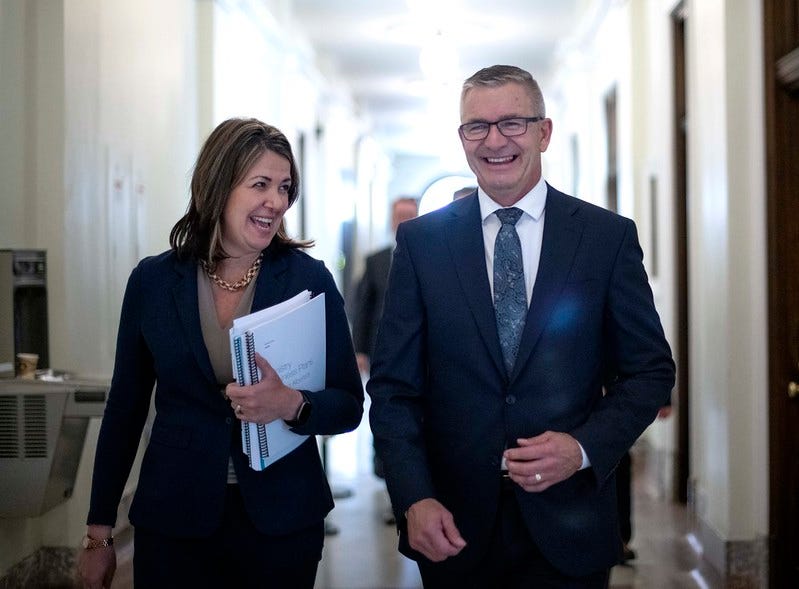Study outlines generational divide in 2023 UCP budget
Report author says a disproportionate gap between spending on those 65+ and under 45 in Alberta indicates insufficient funding for preventative health measures.

A new study from Generation Squeeze, a non-profit run by University of British Columbia public health professor Paul Kershaw, says the 2023 Alberta budget is pitting the young against the elderly.
According to the report, the United Conservatives’ 2023 budget is “one of the most generationally unfair budgets in Canadian history,” and this trend will continue if the issue isn’t raised on the campaign trail
While the budget provides about $16,700 in funding per Albertan over the age of 65, it provides about $9,900 per Albertan under 45 — a gap of $6,800.
This gap is more than that in Ontario ($6,600) and B.C. ($4,800), the two largest majority English-speaking provinces.
Kershaw told The Orchard that perfect parity between spending on seniors and young people is never going to happen, nor is it desirable, since the bulk of the provincial budget is spent on health care.
“We will spend more on people when they're older at a provincial level than when younger because a biological reality of being human is that we consume more medical care when we're older, so we expect the age gap,” said Kershaw.
Alberta’s health-care system, the study notes, costs less than $3,000 a person under age 25. By the time they’re 45, that cost increases to $4,000 a year and when they reach 65 their health care costs $9,000 annually. By the time they’re 85, health care costs $30,000 a year. That’s 85% of health-care costs spent on those aged 65 to 85.
Alberta, however, has a younger population than Ontario or B.C., with a median age of 38, compared to 40 in Ontario and 42 in B.C. This suggests Alberta should be spending proportionately more than the comparable provinces on younger people, rather than the reverse.
So what’s the ideal ratio? Kershaw said that depends:
If it were the case that today's young people were particularly financially well-off, and today's older population were particularly financially vulnerable, then you would anticipate that our larger age gap would make sense. But actually in Canada today, economic vulnerability has been shifting from older to younger for some time now.
Older folks, including in Alberta, report the lowest rates of low income in any age group, they have the most wealth and economic vulnerabilities shifted from them towards younger people. And so you see that in terms of increased amounts of housing unaffordability for younger people, longer times to have to save to get a downpayment in Alberta, means more of them are renting in higher rents, and more economic precarity.
“The typical 25-34 year-old earns little more for full-time work than did the same age person in 1976, despite devoting years more to postsecondary, and facing higher housing prices after inflation,” the report notes.
The largest increase in spending in the 2023 provincial budget is going towards health care, and understandably so. Of the $6.5 billion in enhanced spending on health care, K-12 and post-secondary education, and social services, 58% is going to health care.
The problem with this, Kershaw explains, is that we ought to be protecting people from needing to access medical care to the greatest possible extent by increasing funding in other areas.
“The health science tells us you would slow the flow of sickness into your doctor's offices and emergency rooms if you were more urgently growing spending on technology, child care, housing affordability, poverty reduction, reconciliation, fighting climate change, and so on,” he said.
“The last stop in our health really should be the doctor's office or the emergency room. The first steps are in our neighborhoods, in our childcare settings, in our schools, in our jobs, and in our environment.”
Kershaw emphasized that his report isn’t an effort to pit generations against each other, but to comment on the fact the government is already doing so, and chart a path forward.
A good place to start, he said, is for the government to begin tracking data on how spending breaks down per capita by age cohort.
“Drawing attention to sex comparisons in public investment or in earnings isn't necessarily pitting sexes against one another. The economy's doing that, public policy is doing that, and the question is then, how do we see that comparison, see the numbers and then respond? It's the same way with his generational analysis,” Kershaw said.

Policy Highlights from the 2023 Liberal Policy Convention
Canada’s governing Liberals adopted 24 non-binding policy resolutions at its national convention held in Ottawa last week, which were ranked in order of import.
The resolution that received the most attention was titled “Combatting Disinformation in Canada,” which was sponsored by the party’s B.C. wing and ranked 10th.
It consists of two components — one eminently reasonable and the other an insane attempt at partisan censorship — but the former was greatly overshadowed by the latter, soiling the entire resolution. Prime Minister Justin Trudeau suggested he has no intention of implementing either.
Keep reading with a 7-day free trial
Subscribe to The Orchard to keep reading this post and get 7 days of free access to the full post archives.


